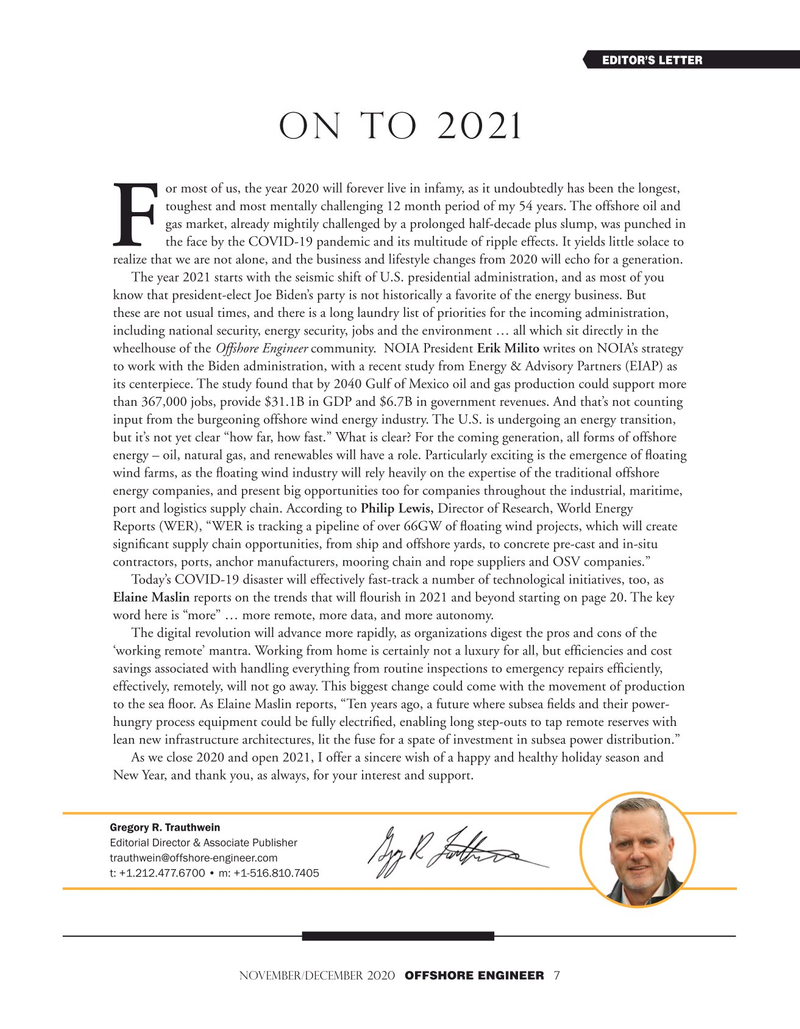
Page 7: of Offshore Engineer Magazine (Nov/Dec 2020)
Read this page in Pdf, Flash or Html5 edition of Nov/Dec 2020 Offshore Engineer Magazine
EDITOR’S LETTER
On to 2021 or most of us, the year 2020 will forever live in infamy, as it undoubtedly has been the longest, toughest and most mentally challenging 12 month period of my 54 years. The offshore oil and gas market, already mightily challenged by a prolonged half-decade plus slump, was punched in the face by the COVID-19 pandemic and its multitude of ripple effects. It yields little solace to
F realize that we are not alone, and the business and lifestyle changes from 2020 will echo for a generation.
The year 2021 starts with the seismic shift of U.S. presidential administration, and as most of you know that president-elect Joe Biden’s party is not historically a favorite of the energy business. But these are not usual times, and there is a long laundry list of priorities for the incoming administration, including national security, energy security, jobs and the environment … all which sit directly in the wheelhouse of the Offshore Engineer community. NOIA President Erik Milito writes on NOIA’s strategy to work with the Biden administration, with a recent study from Energy & Advisory Partners (EIAP) as its centerpiece. The study found that by 2040 Gulf of Mexico oil and gas production could support more than 367,000 jobs, provide $31.1B in GDP and $6.7B in government revenues. And that’s not counting input from the burgeoning offshore wind energy industry. The U.S. is undergoing an energy transition, but it’s not yet clear “how far, how fast.” What is clear? For the coming generation, all forms of offshore energy – oil, natural gas, and renewables will have a role. Particularly exciting is the emergence of ?oating wind farms, as the ?oating wind industry will rely heavily on the expertise of the traditional offshore energy companies, and present big opportunities too for companies throughout the industrial, maritime, port and logistics supply chain. According to Philip Lewis, Director of Research, World Energy
Reports (WER), “WER is tracking a pipeline of over 66GW of ?oating wind projects, which will create signi?cant supply chain opportunities, from ship and offshore yards, to concrete pre-cast and in-situ contractors, ports, anchor manufacturers, mooring chain and rope suppliers and OSV companies.”
Today’s COVID-19 disaster will effectively fast-track a number of technological initiatives, too, as
Elaine Maslin reports on the trends that will ?ourish in 2021 and beyond starting on page 20. The key word here is “more” … more remote, more data, and more autonomy.
The digital revolution will advance more rapidly, as organizations digest the pros and cons of the ‘working remote’ mantra. Working from home is certainly not a luxury for all, but ef?ciencies and cost savings associated with handling everything from routine inspections to emergency repairs ef?ciently, effectively, remotely, will not go away. This biggest change could come with the movement of production to the sea ?oor. As Elaine Maslin reports, “Ten years ago, a future where subsea ?elds and their power- hungry process equipment could be fully electri?ed, enabling long step-outs to tap remote reserves with lean new infrastructure architectures, lit the fuse for a spate of investment in subsea power distribution.”
As we close 2020 and open 2021, I offer a sincere wish of a happy and healthy holiday season and
New Year, and thank you, as always, for your interest and support.
Gregory R. Trauthwein
Editorial Director & Associate Publisher [email protected] \]>^>^_@@`@qqx\]>{|>`X>q@_q|
NOVEMBER/DECEMBER 2020 OFFSHORE ENGINEER 7

 6
6

 8
8